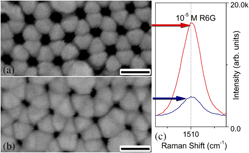Crossref Citations
This article has been cited by the following publications. This list is generated based on data provided by
Crossref.
Liu, Chang
Qu, Yueyang
Luo, Yong
and
Fang, Ning
2011.
Recent advances in single‐molecule detection on micro‐ and nano‐fluidic devices.
ELECTROPHORESIS,
Vol. 32,
Issue. 23,
p.
3308.
Yue, Jun
Schouten, Jaap C.
and
Nijhuis, T. Alexander
2012.
Integration of Microreactors with Spectroscopic Detection for Online Reaction Monitoring and Catalyst Characterization.
Industrial & Engineering Chemistry Research,
Vol. 51,
Issue. 45,
p.
14583.
Yu, Wei W.
and
White, Ian M.
2012.
A simple filter-based approach to surface enhanced Raman spectroscopy for trace chemical detection.
The Analyst,
Vol. 137,
Issue. 5,
p.
1168.
Kim, Jaeyoun
2012.
Joining plasmonics with microfluidics: from convenience to inevitability.
Lab on a Chip,
Vol. 12,
Issue. 19,
p.
3611.
Yazdi, Soroush H.
and
White, Ian M.
2012.
Optofluidic Surface Enhanced Raman Spectroscopy Microsystem for Sensitive and Repeatable On-Site Detection of Chemical Contaminants.
Analytical Chemistry,
Vol. 84,
Issue. 18,
p.
7992.
Yazdi, Soroush H.
and
White, Ian M.
2012.
3-D nanoporous optofluidic device for high sensitivity SERS detection.
p.
1.
Guo, Yunbo
Khaing Oo, Maung Kyaw
Reddy, Karthik
and
Fan, Xudong
2012.
Ultrasensitive Optofluidic Surface-Enhanced Raman Scattering Detection with Flow-through Multihole Capillaries.
ACS Nano,
Vol. 6,
Issue. 1,
p.
381.
Tung, Yi-Chung
Huang, Nien-Tsu
Oh, Bo-Ram
Patra, Bishnubrata
Pan, Chi-Chun
Qiu, Teng
Chu, Paul K.
Zhang, Wenjun
and
Kurabayashi, Katsuo
2012.
Optofluidic detection for cellular phenotyping.
Lab on a Chip,
Vol. 12,
Issue. 19,
p.
3552.
Wei, Hong
and
Xu, Hongxing
2013.
Hot spots in different metal nanostructures for plasmon-enhanced Raman spectroscopy.
Nanoscale,
Vol. 5,
Issue. 22,
p.
10794.
Yu, Wei W.
and
White, Ian M.
2013.
Inkjet-printed paper-based SERS dipsticks and swabs for trace chemical detection.
The Analyst,
Vol. 138,
Issue. 4,
p.
1020.
Yazdi, Soroush H.
and
White, Ian M.
2013.
Multiplexed detection of aquaculture fungicides using a pump-free optofluidic SERS microsystem.
The Analyst,
Vol. 138,
Issue. 1,
p.
100.
Oh, Young-Jae
and
Jeong, Ki-Hun
2014.
Optofluidic SERS chip with plasmonic nanoprobes self-aligned along microfluidic channels.
Lab on a Chip,
Vol. 14,
Issue. 5,
p.
865.
Schlücker, Sebastian
2014.
Oberflächenverstärkte Raman‐Spektroskopie: Konzepte und chemische Anwendungen.
Angewandte Chemie,
Vol. 126,
Issue. 19,
p.
4852.
Schlücker, Sebastian
2014.
Surface‐Enhanced Raman Spectroscopy: Concepts and Chemical Applications.
Angewandte Chemie International Edition,
Vol. 53,
Issue. 19,
p.
4756.
Yang, Xuan
Yang, Miaoxin
Pang, Bo
Vara, Madeline
and
Xia, Younan
2015.
Gold Nanomaterials at Work in Biomedicine.
Chemical Reviews,
Vol. 115,
Issue. 19,
p.
10410.
Coté, Gerard L.
Nieuwoudt, Michél K.
Martin, Jacob W.
Oosterbeek, Reece N.
Novikova, Nina I.
Wang, Xindi
Malmström, Jenny
Williams, David E.
and
Simpson, M. C.
2015.
Gold sputtered Blu-Ray disks as novel and cost effective sensors for surface enhanced Raman spectroscopy.
Vol. 9332,
Issue. ,
p.
933207.
Shen, Wei
Lin, Xuan
Jiang, Chaoyang
Li, Chaoyu
Lin, Haixin
Huang, Jingtao
Wang, Shuo
Liu, Guokun
Yan, Xiaomei
Zhong, Qiling
and
Ren, Bin
2015.
Reliable Quantitative SERS Analysis Facilitated by Core–Shell Nanoparticles with Embedded Internal Standards.
Angewandte Chemie International Edition,
Vol. 54,
Issue. 25,
p.
7308.
Shen, Wei
Lin, Xuan
Jiang, Chaoyang
Li, Chaoyu
Lin, Haixin
Huang, Jingtao
Wang, Shuo
Liu, Guokun
Yan, Xiaomei
Zhong, Qiling
and
Ren, Bin
2015.
Reliable Quantitative SERS Analysis Facilitated by Core–Shell Nanoparticles with Embedded Internal Standards.
Angewandte Chemie,
Vol. 127,
Issue. 25,
p.
7416.
Yüksel, Sezin
Schwenke, Almut M.
Soliveri, Guido
Ardizzone, Silvia
Weber, Karina
Cialla-May, Dana
Hoeppener, Stephanie
Schubert, Ulrich S.
and
Popp, Jürgen
2016.
Trace detection of tetrahydrocannabinol (THC) with a SERS-based capillary platform prepared by the in situ microwave synthesis of AgNPs.
Analytica Chimica Acta,
Vol. 939,
Issue. ,
p.
93.
Nieuwoudt, Michél K.
Martin, Jacob W.
Oosterbeek, Reece N.
Novikova, Nina I.
Wang, Xindi
Malmström, Jenny
Williams, David E.
and
Simpson, M. Cather
2016.
Gold-sputtered Blu-ray discs: simple and inexpensive SERS substrates for sensitive detection of melamine.
Analytical and Bioanalytical Chemistry,
Vol. 408,
Issue. 16,
p.
4403.





